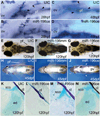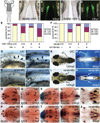miR-196 regulates axial patterning and pectoral appendage initiation
- PMID: 21787766
- PMCID: PMC3164755
- DOI: 10.1016/j.ydbio.2011.07.014
miR-196 regulates axial patterning and pectoral appendage initiation
Abstract
Vertebrate Hox clusters contain protein-coding genes that regulate body axis development and microRNA (miRNA) genes whose functions are not yet well understood. We overexpressed the Hox cluster microRNA miR-196 in zebrafish embryos and found four specific, viable phenotypes: failure of pectoral fin bud initiation, deletion of the 6th pharyngeal arch, homeotic aberration and loss of rostral vertebrae, and reduced number of ribs and somites. Reciprocally, miR-196 knockdown evoked an extra pharyngeal arch, extra ribs, and extra somites, confirming endogenous roles of miR-196. miR-196 injection altered expression of hox genes and the signaling of retinoic acid through the retinoic acid receptor gene rarab. Knocking down rarab mimicked the pectoral fin phenotype of miR-196 overexpression, and reporter constructs tested in tissue culture and in embryos showed that the rarab 3'UTR is a miR-196 target for pectoral fin bud initiation. These results show that a Hox cluster microRNA modulates development of axial patterning similar to nearby protein-coding Hox genes, and acts on appendicular patterning at least in part by modulating retinoic acid signaling.
Copyright © 2011 Elsevier B.V. All rights reserved.
Figures







Similar articles
-
The Polycomb group protein Ring1b is essential for pectoral fin development.Development. 2012 Jun;139(12):2210-20. doi: 10.1242/dev.077156. Development. 2012. PMID: 22619390
-
Latent developmental potential to form limb-like skeletal structures in zebrafish.Cell. 2021 Feb 18;184(4):899-911.e13. doi: 10.1016/j.cell.2021.01.003. Epub 2021 Feb 4. Cell. 2021. PMID: 33545089
-
Combinatorial roles for zebrafish retinoic acid receptors in the hindbrain, limbs and pharyngeal arches.Dev Biol. 2009 Jan 1;325(1):60-70. doi: 10.1016/j.ydbio.2008.09.022. Epub 2008 Oct 2. Dev Biol. 2009. PMID: 18929555 Free PMC article.
-
Tri-phasic expression of posterior Hox genes during development of pectoral fins in zebrafish: implications for the evolution of vertebrate paired appendages.Dev Biol. 2008 Oct 1;322(1):220-33. doi: 10.1016/j.ydbio.2008.06.032. Epub 2008 Jul 3. Dev Biol. 2008. PMID: 18638469
-
MicroRNAs in the Hox network: an apparent link to posterior prevalence.Nat Rev Genet. 2008 Oct;9(10):789-96. doi: 10.1038/nrg2400. Nat Rev Genet. 2008. PMID: 18781158 Free PMC article. Review.
Cited by
-
Deep sequencing and expression of microRNAs from early honeybee (Apis mellifera) embryos reveals a role in regulating early embryonic patterning.BMC Evol Biol. 2012 Nov 2;12:211. doi: 10.1186/1471-2148-12-211. BMC Evol Biol. 2012. PMID: 23121997 Free PMC article.
-
The dlx5a/dlx6a genes play essential roles in the early development of zebrafish median fin and pectoral structures.PLoS One. 2014 May 23;9(5):e98505. doi: 10.1371/journal.pone.0098505. eCollection 2014. PLoS One. 2014. PMID: 24858471 Free PMC article.
-
Frontofacionasal Dysplasia in a Newborn with a De Novo Duplication of 7p15.2-p15.1.AJP Rep. 2015 Oct;5(2):e111-e1115. doi: 10.1055/s-0035-1549299. Epub 2015 May 15. AJP Rep. 2015. PMID: 26495166 Free PMC article.
-
Expanding the annotation of zebrafish microRNAs based on small RNA sequencing.Gene. 2014 Aug 10;546(2):386-9. doi: 10.1016/j.gene.2014.05.036. Epub 2014 May 15. Gene. 2014. PMID: 24835514 Free PMC article.
-
miRNAs in Bone Development.Curr Genomics. 2015 Dec;16(6):427-34. doi: 10.2174/1389202916666150817202425. Curr Genomics. 2015. PMID: 27019617 Free PMC article.
References
-
- Amores A, Force A, Yan YL, Joly L, Amemiya C, Fritz A, Ho RK, Langeland J, Prince V, Wang YL, Westerfield M, Ekker M, Postlethwait JH. Zebrafish hox clusters and vertebrate genome evolution. Science. 1998;282:1711–1714. - PubMed
-
- Asli NS, Kessel M. Spatiotemporally restricted regulation of generic motor neuron programs by miR-196-mediated repression of Hoxb8. Dev Biol. 2010;344:857–868. - PubMed
-
- Bagnall KM, Higgins SJ, Sanders EJ. The contribution made by a single somite to the vertebral column: experimental evidence in support of resegmentation using the chick-quail chimaera model. Development. 1988;103:69–85. - PubMed
Publication types
MeSH terms
Substances
Grants and funding
LinkOut - more resources
Full Text Sources
Molecular Biology Databases

